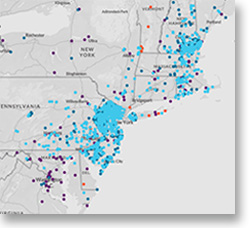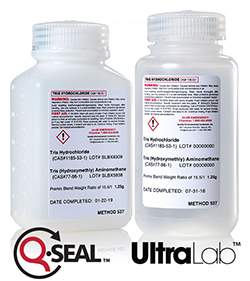 Autumn • 2023 Autumn • 2023 |
In this Issue: |
  |
EPA releases first round of UCMR 5 data In August the US Environmental Protection Agency released the first data set from the Fifth Unregulated Contaminant Monitoring Rule (UCMR 5). The data released is the first of 12 data sets that will be released quarterly between now and 2026.
The initial round of UCMR 5 data confirms that 431 water systems have PFAS levels above minimum reporting limits. A 2020 study published by scientists at the Environmental Working Group (EWG) that estimated more than 200 million Americans could have PFAS in their drinking water. EWG has published an interactive map that shows public and private water systems known to be contaminated with PFAS at more than 2,800 locations in 50 states, the District of Columbia and two territories. The true scale of PFAS contamination could be much greater. Sources: Association of State Drinking Water Administrators, Environmental Working Group |
 |
Researchers use ultrasound to break PFAS bonds New research at The Ohio State University is studying how ultrasonic degradation, a process that uses sound to degrade substances by cleaving apart the molecules that make them up, might work against different types and concentrations of these chemicals. The research was published in The Journal of Physical Chemistry A. By conducting experiments on lab-made mixtures containing three differently sized PFAS compounds of fluorotelomer sulfonates, their results showed that over a period of three hours, the smaller compounds degraded much faster than the larger ones. This is in contrast to many other PFAS treatment methods in which smaller PFAS are actually more challenging to treat. Ultrasound works by emitting sound at an extremely low-pitched pressure wave that compresses and pulls apart the solution, which then creates pockets of vapor called cavitation bubbles. Much like powerful combustion chambers, the temperatures inside these tiny bubbles can reach up to 10,000 Kelvin, and it's this heat that breaks down the stable carbon-fluorine bonds that PFAS are made of and renders the byproducts essentially harmless Source: https://phys.org/news/2023-09-ultrasound-groundwater-toxic-chemicals.html |
 |
Best choices for PFAS sampling Whether sampling under EPA methods 537.1 or 533, or one of the several alternative methods in use today, QEC has the right container and the right preparation for your PFAS sampling requirements. Our Q-Seal™ HDPE oblongs and our UltraLab™ wide mouth polypropylene containers are trusted by labs everywhere as reliable for PFAS sampling. Both are precision-engineered for leak-proof performance in the field and in the laboratory. For an additional fee QEC's expert technicians can preserve your PFAS containers to exact specifications. Please contact our customer service team for more information on how QEC can support your PFAS sampling program. |
 |
Scientists use quantum mechanics to slow down For the first time, scientists have directly observed a molecular dance that's crucial to basic chemical reactions such as photosynthesis. And they've done it by using a quantum computer to slow down a chemical reaction by a mind-boggling 100 billion times. The new study, published Aug. 28 in the journal Nature Chemistry, focused on a kind of molecular interaction known as a conical intersection. Conical intersections are points in the geometry of molecules where the energy between two surfaces is equal. They act a bit like funnels between electronic states, allowing for quick transitions that usher along chemical reactions. Conical intersections occur in a lot of reactions, including everyday ones like photosynthesis and the light-detecting reactions that take place in the retina. Because these reactions happen so quickly, though, scientists had never observed a conical intersection in action. To do so, researchers at the University of Sydney used a device called a trapped-ion quantum computer, which locks quantum particles into electrical fields and manipulates them with lasers. In nature, the whole process is over within femtoseconds-- That's a billionth of a millionth — or one quadrillionth — of a second. Using a quantum computer, scientists built a system that slowed down the chemical dynamics from femtoseconds to milliseconds. This slowdown allowed the researchers to take meaningful measurements of the reaction as it occurred. This was a direct analog observation of the quantum dynamics unfolding at an observable speed. Understanding these ultrafast dynamics could yield new insight into chemical reactions for a variety of applications. |
| © 2023 | Quality Environmental Containers, Inc. |

